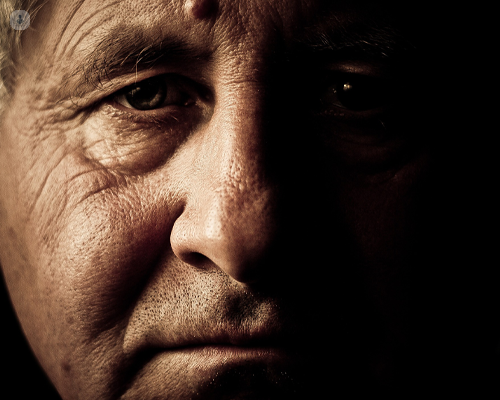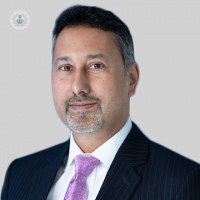Liver cancer causes, symptoms, outlook and treatment
Written by:Primary liver cancer is estimated to be one of the most common causes of death from cancer globally. It is particularly dangerous due to its lack of early warning signs. Professor Shahid Khan is a leading London gastroenterologist and hepatologist, with a special clinical interest in the treatment of liver cancer - learn from him about the causes, symptoms, outlook and treatment of the condition.

What is primary liver cancer?
There two main types of liver cancer (broadly speaking):primary liver cancer and secondary liver cancer.
- Primary liver cancer is cancer that originally starts within the liver
- Secondary liver cancer means that the cancer has occurred from metastasis (when cancer spreads from one part of the body to another). So, if a tumour starts in a breast, bowel or lung, for example, it can spread to the liver, resulting in secondary liver cancer.
Primary liver cancer is a very important cancer, particularly when considered globally. It’s estimated to be the third or fourth most common cause in death in humans from cancer.
What causes primary liver cancer?
The biggest known cause of primary liver cancer is chronic liver disease. In fact, it is estimated that over 80 per cent of primary liver cancers occur in people with chronic liver disease.
If someone has on-going liver damage for a long time, particularly underlying cirrhosis, their risk is raised. Any cause of chronic liver disease (which can eventually lead to cirrhosis over a number of years) is a big risk factor for primary liver cancer. Liver disease/cirrhosis can be:
- alcohol-related
- fatty-liver-related
- caused by hepatitis C or hepatitis B
- caused by autoimmune diseases including autoimmune hepatitis, primary biliary cholangitis and primary sclerosing cholangitis
- caused by some genetic conditions such as haemochromatosis
There are two main types of primary liver cancer. Hepatocellular carcinoma (HCC) is the most common type with 80-90 per cent of sufferers having cirrhosis or underlying liver disease. The second most common type of primary liver cancer is cholangiocarcinoma (also called bile duct cancer). In this type, around 40 per cent have pre-existing liver disease.
Generally, the majority of patients have an identifiable cause of liver cancer but for a minority, we do not know.
What are the symptoms of liver cancer?
Early-stage
Liver cancer is particularly dangerous because it usually doesn’t cause symptoms in its early stage. Inside the liver, there are not many nerve fibres and consequently, a tumour won’t affect so many nerves that result in noticeable symptoms.
Middle-stage
Once a tumour gets bigger and bigger, vague symptoms like discomfort, loss of appetite, weight loss, nausea and malaise. These symptoms are not specific to liver cancer however, meaning people don’t immediately know they need their liver checked – this is what makes liver cancer dangerous.
Advanced-stage
In advanced cases, liver cancer can cause jaundice.
What is the outlook for a liver cancer diagnosis?
Sadly, in the majority of cases, liver cancer is not curable at the stage it causes symptoms and is thus diagnosed. That’s why anyone at risk of liver disease should see a specialist. If we know someone has chronic liver disease, we can carry out regular surveillance tests, including scans, to make sure we pick up cancer at an early stage while it is still potentially curable.
If liver cancer is diagnosed early and the tumour is resectable (i.e. it can be surgically removed) or ablatable (can be destroyed with targeted microwave or radiofrequency therapy), the outlook is much improved.

How is liver cancer diagnosed?
Usually, liver cancer starts to undergo the diagnostic process when a patient sees a doctor for the previously mentioned vague symptoms. Once they undergo blood tests and a liver test and receive abnormal results, they’ll be referred for scans.
Firstly, an ultrasound scan is used to get an overall look at the liver. If a sonographer (the person conducting the ultrasound) spots something suspicious, they will refer the patient for further scans. “Something suspicious” would be a lesion (a lump or anything abnormal). Even if the sonographer sees a lump, this does not mean it is cancer. A lump could instead be benign (non-cancerous) e.g. a cyst, scar tissue, or an area of fat. It’s not possible to determine if it’s cancerous via ultrasound, so further tests are needed.
The next test after an ultrasound is a contrast-enhanced CT scan (CAT) or MRI scan. Contrast is a special dye to highlight parts of the body being examined, and a contrast scan will provide a much more detailed view of the lesion (lump) in the liver. The contrast will be given to the patient intravenously and it will flow in and out of the lump. We wait for the contrast to circulate throughout the lump and take multiple pictures at various times – and from the pattern of images we can usually determine if the lump is cancerous or not, based on how long the contrast takes to move through the lump.
Hepatocellular carcinoma (HCC) and cholangiocarcinoma, the two main types of primary liver cancer, also have specific blood tests to help diagnose them in many cases but not all.
If the diagnosis is still unclear, sometimes we will do a biopsy of the area. This is performed by a radiologist under ultrasound guidance. It’s not an operation and the radiologist will inject a needle into the liver and take a sample – patients can go home on the same day.
What are the treatment options for primary liver cancer?
Surgical resection (removal)
The best primary liver cancer treatment is resection (chopping the tumour out), which is only possible in early-stage liver cancer. For those who can have the tumour cut out, the long-term prognosis is quite positive. However, even if the tumour is cut out, the cancer can come back in up to half of patients within five years, particularly if they continue to have the underlying risk factor of liver disease or cirrhosis. That’s why we do very close monitoring after a resection, which involves a scan every 3 months for the first few years after surgery to make sure the cancer doesn’t come back, or to be able to treat it again quickly if it does.
Ablation
If the tumour is small (less than 3 cm) and in a location that can be accessed externally, we can perform ablation. This is a less invasive procedure than resection as no operation is required. Instead, the tumour is destroyed with micro-waves or radiofrequency waves while the patient is under general anaesthetic. An ablation procedure typically lasts 20 minutes and involves one night in hospital. What’s more, it doesn’t leave a scar.
Liver transplant
Sometimes, if a patient cannot have either resection or ablation and they have liver failure, they might be eligible for a liver transplant, but not if liver failure is very advanced, or of the cancer is very advanced.
Transaretrial Chemoembolization (TACE)
If a patient can’t have resection, ablation or a liver transplant, they could be offered chemoembolization (TACE). In this procedure, a line is passed into the artery that is feeding blood to the tumour. Chemotherapy is injected directly into the tumour and then the blood supply to the tumour is embolised, meaning the blood supply is blocked. To do TACE safely, the liver must have reasonably good function and have a feeding artery that is accessible. It’s important to know that chemoembolization is not usually curative but it can significantly reduce the tumour’s size and improve overall survival.
Systemic therapy
If none of the previously mentioned treatments are possible, an alternative treatment is systemic therapy, which means cancer treatment that targets the entire body (e.g. chemotherapy and immunotherapy) and several types are used.
Clinical trials
If existing treatments options aren’t applicable, there are clinical trials for patients who are willing to try new treatments for liver cancer. If there is a trial being done for a new therapy and a patient is eligible to take part in the trial, a specialist will present it to them.
Discover how Professor Khan can help you regarding your gastroenterology or hepatology needs – visit his Top Doctors profile to arrange a consultation.


